#texture/background practice also
Explore tagged Tumblr posts
Text

one last late night doodle of this guy before i tweek his design
if you’re curious what the text says, it reads “Where ya been, BUG?”
haha y’know like .. computer bug (da dum tss)
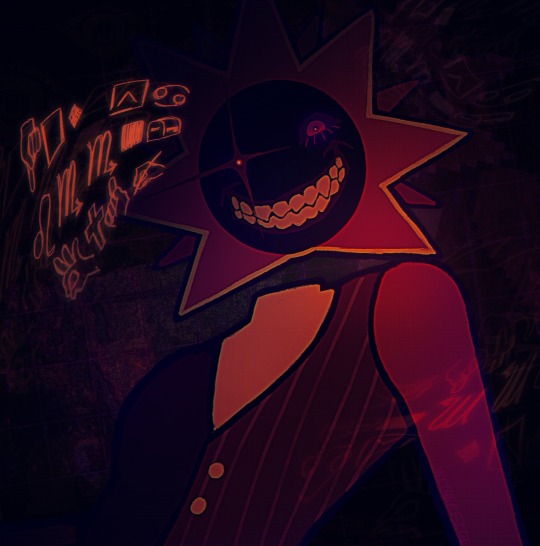

reblogs are appreciated!!!
#mels art#vanniclips! au#fnaf daycare attendant#fnaf eclipse#balloon world eclipse#fnaf au#fnaf dca au#the design worked well for my artblock at the time i made him but it’s gotta go#did the same style as i did with the others#my crazy fuck <3#art#illustration#texture/background practice also#id in alt text#horror#eye contact#scopophobia
458 notes
·
View notes
Text
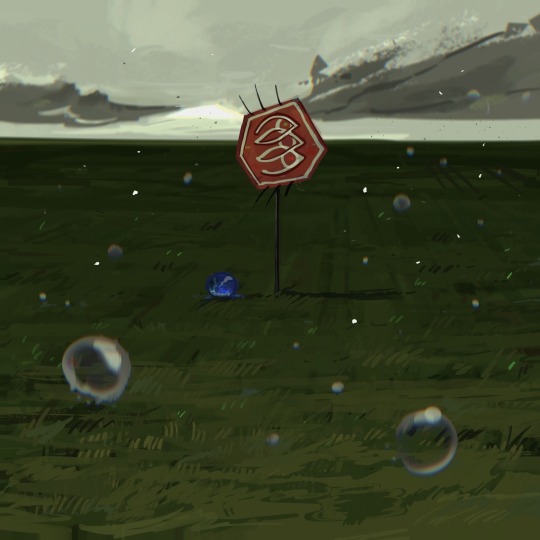
🟩🔵🛑🫧
#my art#background practice#background art#reposting bc like;:’ I didn’t like it and needed to do several touch ups#on the grass mostly#still learning about texturing grass#also added bubbles just for fun
113 notes
·
View notes
Text
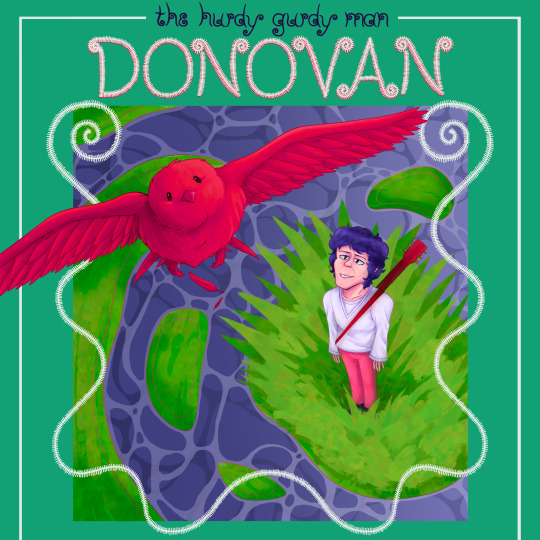

A Hurdy Gurdy Man-related drawing that I did for school 🍃 HAPPY BIRTHDAY, DONOVAN!!
youtube
(Donovan's record producer being dramatic under the cut teehee)
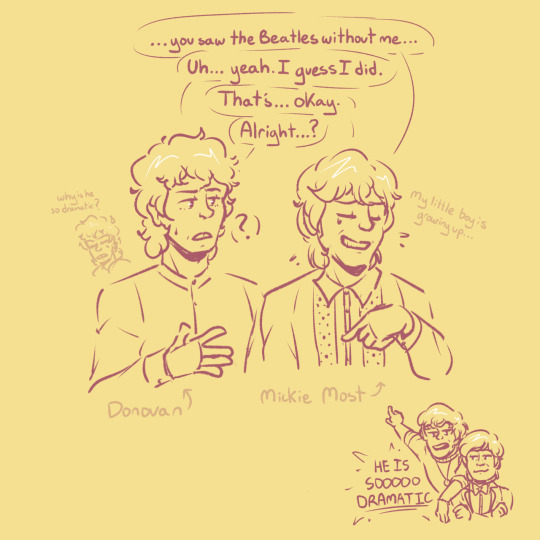
#was working on this in the background when i went to london and ooHhHh I'M SO HAPPY WITH HOW IT TURNED OUT!!!!!#i'm still experimenting with doing more painterly stuff in my style but being able to practice via school assignments is always fun!!!!#the purpose of this assignment was to redraw the cover of any piece of media of our choosing with different textures and i chose don#since the scenery is THERE and i wanted to draw him too 🥹#'the hurdy gurdy man' is soooo good very good album (even if 'mellow yellow' is my favorite don album) I STILL LOVE 'THE HURDY GURDY MAN'#favorite song is 'get thy bearings' buuut i have a soft spot for 'as i recall it'#GIVE ME JAZZY/SWING DONOVAN#'get thy bearings' is also a big comfort song for me though#pink pants#i literally lowkey threw a dart at a board with regards to choosing an outfit for him 😔#there aren't a ton of donovan circa 1968 references in good quality aghghh and i wanted something contrasting#WHEEE SO MUCH FUN TO PUT THIS TOGETHER!!#brought my copy of 'the hurdy gurdy man' with me to london just for posterity#funny how most of donovan's albums never relased in the uk WHAT HAPPENED MICKIE. WHAT HAPPENED. I MUST KNOW.#thinking about how donovan mentioned writing 'hurdy gurdy man' for jimi hendrix but the moment mickie heard it#he was like 'donovan you HAVE to record this' and donovan's like 'but mickie i wanted jimi hendrix to record it'#so mickie called chas up and asked him if jimi was able to record and chas said 'no jimi is busy touring'#and mickie was like 'OH WELL DONOVAN I GUESS WE HAVE TO RECORD IT TEEHEE'#silly record producer...... he and chas' dynamic is sooo funny#I LOVE THE LORE AAAAAA#donovan#donovan leitch#the hurdy gurdy man#hurdy gurdy man#1968#classic rock#60s rock#classic rock fanart#devil in her art#mickie most
6 notes
·
View notes
Text
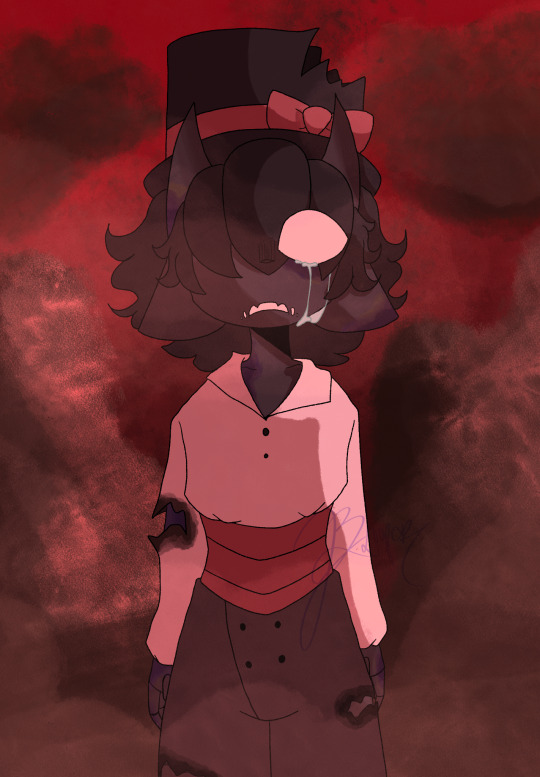
I NEED TO KNOW IF DAPPER IS OK I HAVE TO- AAAAA-
This was a doodle turned practice- I wanna draw backgrounds better-
#bloo’s art :)#qsmp#qsmp fanart#qsmp dapper#I miss her#I want her back#Bad please tell me dapper is ok#I will cry#like ugly cry if he isn’t#anyways#I hate the background#but it’s practice#also I was messing around with new brushes#I love textured art-
36 notes
·
View notes
Note
do u have any tips for taking inspo from your art style? its SO CHARMING i love it so much :]]
WAAAA TYSM? DUDE????? SOBBING????
i'll be honest i'm not sure how to give tips on that??? but i did make a little manual of how to assimilate the berryjello art vibes so i hope this helps somewhat haha :D

take all i say with a mountain of salt tho cause i have like zero idea what im doing LMAO
#i am just a little guy that likes textures brushes and colors too much#just experimenting is like the number one motivator rly#ALSO REDRAWING MINECRAFT SCREENSHOTS IS GREAT FOR BACKGROUND PRACTICE!!!!!!#always get yourself some good inspiration tho#be it either from pinterest or other artists#cause DAMN it helps a lot
5 notes
·
View notes
Text

Pose practice with oc Mariette. Inspired by one of those belle epoque posters.
#my art#my ocs#vampire#ft mariette#i tried to make a texture for the background that could remind myself of this handmade paper i bought once.. idk if i captured it here#the two hard things of this pose: the legs crossing in perspective.. and also what pose to put the hand in (the one that is down)#decided not to color color so i can practice a simple graphic style i guess#artists on tumblr#illustration
4 notes
·
View notes
Text
reading a book about Magdalene pilgrimages in France and its immediately. Ah I forgot how annoying white spiritualists are and how frustrating Christian centric spiritual frameworks can be
like out the gate the author acknowledges a lot of the people she's talking about believe in pseudo science and are subtly racist towards Indigenous peoples, especially of the Americas, but she points out the pseudo science in a way that still comes off as a bit unfair to the groups she's citing
But there's also something so funny about "there are conversations about the increasing secularization of pilgrimages because you can't tell the catholics apart from the quasi-pagans anymore", from a MENA studies perspective. A lot of holy sites in the MENA are "secular" in that multiple religious groups historically have used them (this has been negatively impacted by colonialism, salafism, etc, but it was the norm for hundreds of years before that). The idea that it's abnormal for multiple faiths to use the same site is odd to me
#cipher talk#Also there was a 'judeo christian' in a context where it was Unnecessary#What do any of yall know about jewish pilgrimage practices. Quickly.#Since Everyone here is catholic or quasi pagan of a Christian background texture. What experience do you have with that#Just a very silly thing to say
3 notes
·
View notes
Text
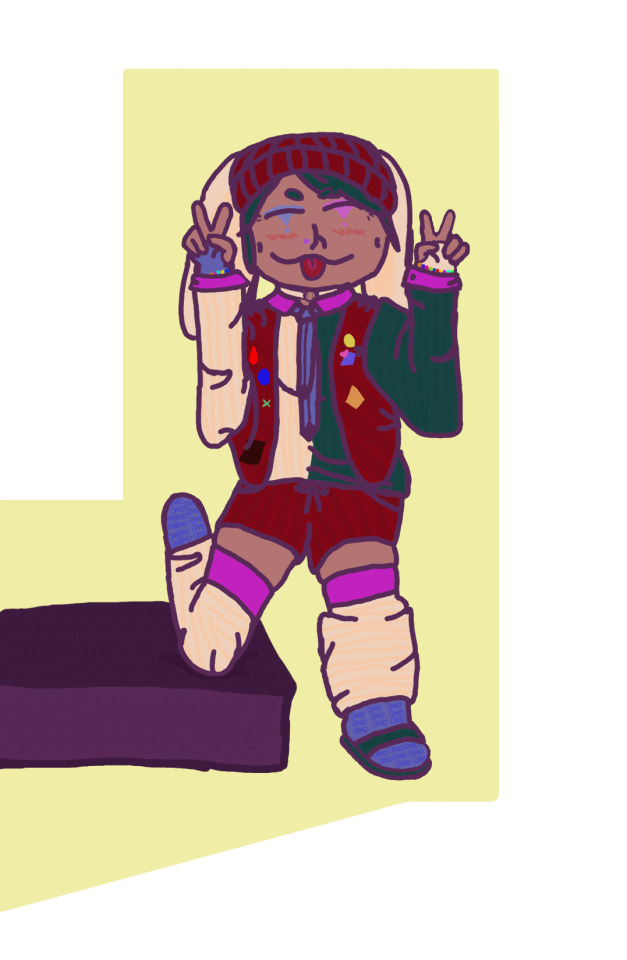
day 3: unnecessarily complex fit
ii gotta be honest, they were originally gonna have two feet but then i couldn't figure out the perspective of their right one so i decided to just not draw it
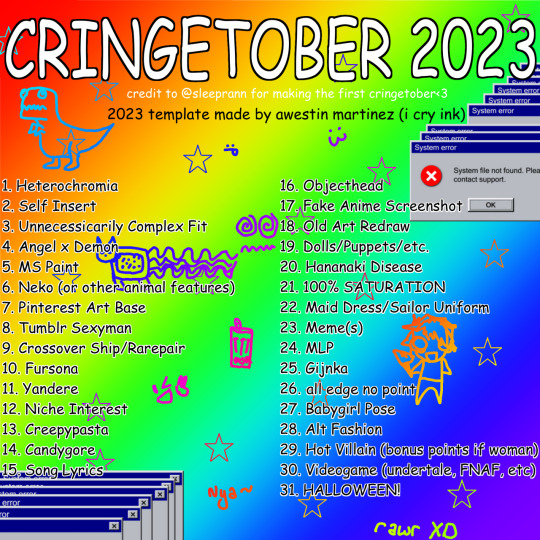
#im aware that its the 13th but i wanted to draw this prompt.. and im like real happy with how this turned out..#could not make myself do shadows because what the fuck are light sources even..#and and i made a silly brush specifically just to use for the texture in this because i thought it would be funny..#yeah and um dont ask the logic behind the color scheme.. i honestly dont think about that shit ever#i just pick colors and go with the flow. you will NOT catch me practicing color theory..#and um yeah..#oh once again i made the smallest things too detailed. so they stand out much more than they're supposed to..#the nose piercing i was able to dial back. but the choker just is like that. and it stands out way too much..#also really appriciate that the shorts look alright because i had no fucking clue what was going on there..#i put off figuring them out for so long that they only made sense once i put the texture on them. which was like one of the last things..#art#my art#cringetober 2023#um#digital art#oh and the background was a total accident.. i had filled the characters surroundings with white to make sure none of my notes and shit wer#visible. and id forgotten about it.. so then when i changed the background color. it basically looked like that already.#i just tweaked it a bit..#tbh im quite glad it happened so because ii struggle with balancing the background between too distracting and a void..#the colors are so fucked for everyone else probably because ive fucked with my monitors gamma levels a lot#basically overall saturation is supposed to be higher. and mainly the dark green is supposed to be a bit more blue-ish..
6 notes
·
View notes
Text
man i fuckibg love doing redraws
#sometimes composition + anatomy take too much work and there’s other things that are both more fun and also need more practice#also like. theyre fun to do#I spent the last little bit testing out a bunch of line art brushes and finally found one with a texture that I’ve been looking to replicat#so that’s nice#and I played around with the colors a bunch although to be fair I do that even when spending a shit ton of time with other stuff#but with redraws it’s fun to try and mimic the color palettes in the original and blend stuff in with the backgrounds#or just create a whole new color palette lol#idk i’m having fun with it#art ramblings
2 notes
·
View notes
Text
Disaster Twins 2025 🐢🐢
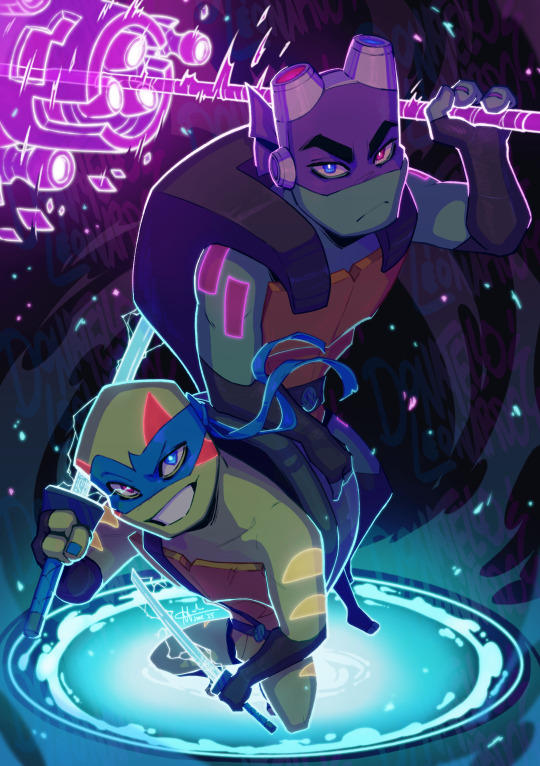
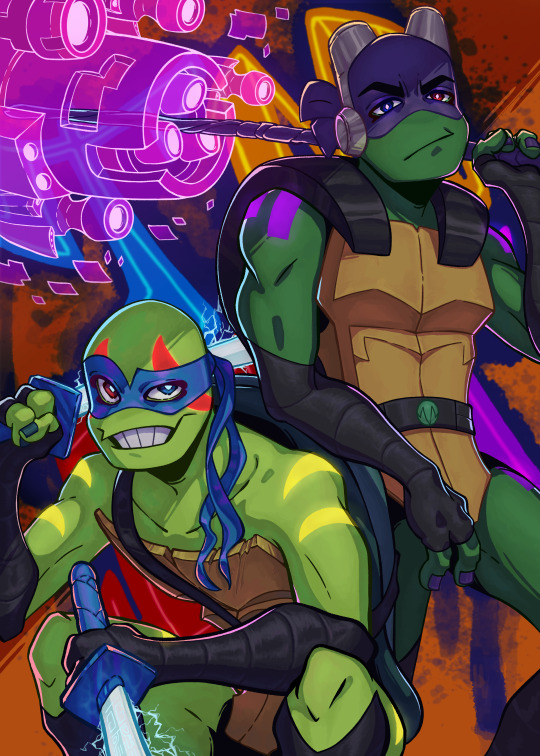
My boys! They look so vastly different in just two and a half years!
I loved doing this redraw, not only for experiencing first hand my newer process and how I've grown, but also being able to look at both finished versions side by side and having visible proof of the evolution of my art. It really goes to show that, while progress isn't always immediate and or linear, time and practice really does equal improvement in the end.
progress pictures, comparisons, and my thoughts on this redraw below:
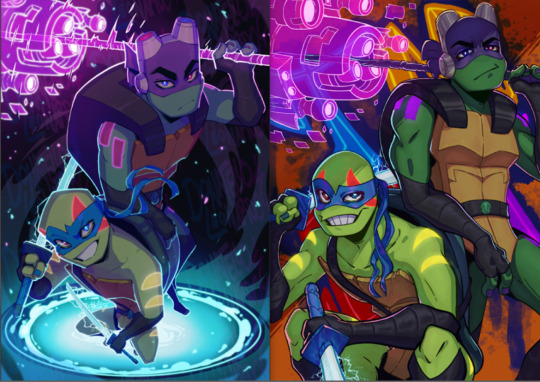
First thing's first, looking at my old art I feel like those poses were the extent of my skill at the time, a real challenge that I set for myself, Leo in particular. I still appreciate them, especially for the first attempt I ever made at drawing any or the turtles, so going into the new one, I really wanted to emulate that same dynamic: Leo crouched down, supporting Donnie's elbow. But I didn't want it to feel as static.
In the new one, I wanted to be more lean in Donnie's pose, as if he's really putting his weight on Leo. Leo himself stayed relatively the same pose-wise, but I felt there was a way to push the pair of them to make it more dynamic. Hence, the perspective.
The second thing I wanted to tackle was the energy of the image. In the old one, I feel it gives more fun, pop-of-color vibes. It's energy was from me trying to take on the Rise style, of attempting to take on the vibrancy of the show and translate it to my art.
Now that I've had a few years to test what works best for me, I feel as though I've improved at balancing the color palettes a bit. I've always favored more muted tones, but always fought the Rise style to find the right give and take, but over time I found a happy medium that tends to lean toward those more muted tones for the body while still adding that pop of color, usually in the eyes or a source of light.
Rim lighting might just be part of my style at this point.
And lastly, I'd like to be able to compliment the original background, but it didn't work for the poses and colors I had going on on Donnie and Leo. The idea was to have a TMNT spray painted on a wall, but since the bodies covered most of the work, it was difficult to tell what was going on.
On the new one, I really leaned into the drama of the scene. They're ready to fight, they're moving, and they're a threat. I didn't want the background to fight with the characters this time around, so starting with the dark, monotone slate helped me smooth out the rest of the ambience before attempting the mystics on Donnie's bo, Leo's portal and what ended up being the wind. And finally the text. I intentionally kept it hard to notice, a small detail that added a bit more texture without distracting and also taking some of the blues and purples throughout the drawing. That last detail, the boy's names, was what I used to mimic the original background.
This ramble turned out a lot longer than I intended, feels like I should end it with "in conclusion" XD
Overall, I'm really happy with how this went and how I've grown since I started drawing tmnt art. Thanks for sticking around to listen to me chatter endlessly, please let me know if this is something you'd wanna read more of in the future!
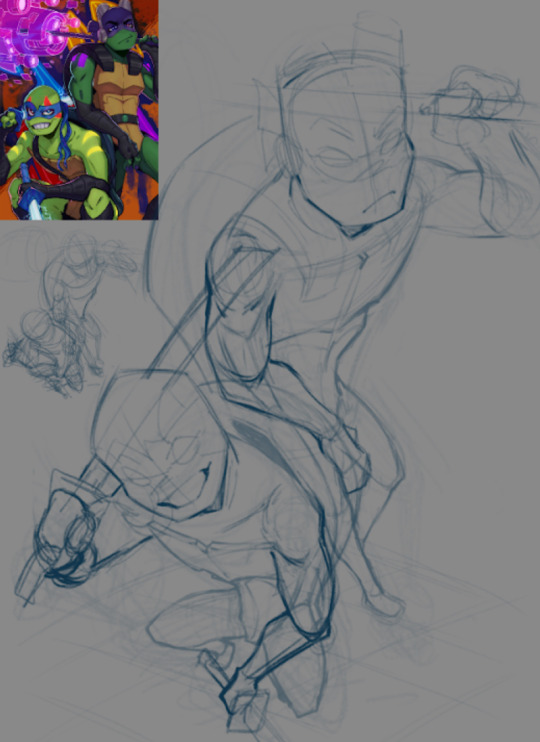
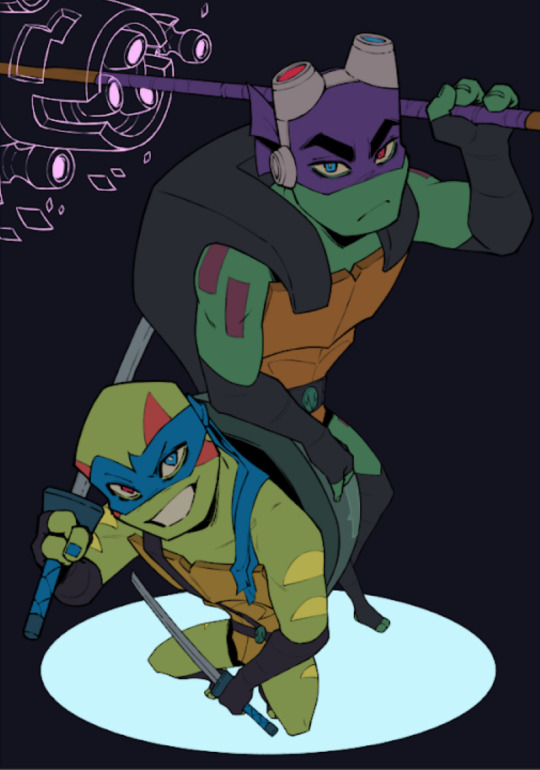
#art#artist on tumblr#rottmnt#tmnt#rise of the teenage mutant ninja turtles#rottmnt leo#rottmnt donnie#redraw#art redraw#redraw 2025#drawing
2K notes
·
View notes
Note
@storytellerash here,
Do you have any tips for making art faster? I figured I would ask you since making a comic requires lots of illustrations at a consistent speed. Other than simplifying the art, is there anything else you've found helpful?
unfortunately shitloads of practice is the only thing I've found that meaningfully helps you get faster, but fortunately if you're trying to draw a comic you're going to get shitloads of practice anyway
To be more specific, in my experience what slows down my art is having to correct things - redraw lines, rework figures that look improperly proportioned on a second glance. But practice is what makes your lines smoother and more confident, and what makes you better at clocking errors earlier and faster. It also helps to practice drawing a diverse range of things - faces from multiple angles, bodies in unusual poses from non-head-on angles, background elements like rocks or trees or buildings, complex textures like fire or the surface of water or a translucent crystal. The more practice you have, the smoother your drawing of it will look and go, because anything will be slow and wobbly the first time you try to capture it on paper. Doing something slow is the first step towards doing it fast.
258 notes
·
View notes
Note
I've been struggling with how to write this out, but the ask box closing gave me an excuse to sit down and make an official attempt at it. Apologies if it's long but I don't think I can compact it without missing some points I wanted to ramble about
I downloaded and played Astronought back in November. I love all its little details, and of course Atom itself.
From the purposefully misspelled title (nought like not/nothing instead of naut like nautical), to how utterly charming Atom is (their general mannerisms, and their laugh… sounds like chittering……), this game is something that has stuck itself in my head
After getting my first ending (route?) it was too late to play a second one & I ended up in the files (wanting to get more of them and this was the easiest way. also curiosity), and THE FILE NAMES? I'M SANE. ABOUT THE FILE NAMES. (Finding out my favorite CG was named "whipped" was very funny, because YEAH. IT TRULY IS, ISN'T IT.) The music that was ALREADY my favorite present in the game AND REALIZING IT'S NAMED "IT SIGHS AND YEARNS AND BEGS TO RETURN" IN THE FILES? YOU REALLY HAD TO DO THAT TO ME, HUH. Very fitting, I applaud you for tugging my heartstrings. At first the SFX named "your favorite" confused me. Until it hit me that it's the lights changing to your favorite colour. ITS THE. AGUHHH. I thought that was a very neat detail and I enjoyed figuring that one out. There's a lot of names in there that I had fun looking over, even if they weren't really meant to be looked at by the average player (?) The game's backgrounds are very well done, too. All of them feel very cohesive :]
Now, onto Atom themselves. Your honour, the worms have unfortunately charmed me. NOT TO MENTION THEY'RE JUST SO FASCINATING? ALL THEIR LITTLE QUIRKS AND EVERY LITTLE FACT. I have a great many questions that I've managed to forget while typing this but I'll try to write them down next time I remember them. However. I love how inhuman they truly are. Their diet is different (THEY can eat kibble, why can't you), their morals are different (murder is okay if it's in retaliation, etc. etc.) HOW THEY CAN GAIN INFORMATION BY EFFECTIVELY CONSUMING SOMEONE? THEY CAN CHANGE THEMSELVES TO BE DIFFERENT MATTERS???? The fact they may as well be buzzing at any form of affection you offer them (They pause when you offer to shake their hand and practically vibrate when you pat them on the shoulder) while still usually being restrained enough to avoid possible issues (it's noted the worms have an odd texture in game, and they don't immediately jump you and instead gingerly wrap a single worm around your finger) is,. oughg I LOVE THE REASON THEY CALL YOU LUNA NOVA, TOO. IT'S ADORABLE Even when they're being a bit more fucked up I still adore them. I got the softer route at first (couldn't say no to them, even if it was a bit illogical in the current situation), and even when I went back for the other route (and by god is that likely a different impression) it just made me MORE interested in it. I could go on.
I went into playing the game knowing the twist, I will admit, but the scene of the reveal was still quite impactful! (possibly quite literally. Atom did take a blunt force hit there) Not to mention how enthralled I got in the escape pod section. It delivered on the tense atmosphere quite well! Each scene was a good build up to the true reveal of what they are and writing this out makes me want to play it again I won't lie to you
Speaking of that general section, Moon Waltz. I got curious and I ended up screenshotting the lyrics it mentions (because I couldn't tear myself away from that moment to look it up right then) and afterwards looking it up (I found it very fitting for it to mention THAT lyric of all of them. think I said something similar out loud). I ended up listening to the song and got it stuck in my head for nearly 3 weeks straight. It's still one of my favorites to this day :]
Even when I tried getting to bed I was still kept up by writing down little ideas I had for them. I do not think I've ever had a game revive my spark of creativity as fast as Astronought did. I still have a lot of those ideas to get to and I honestly hope I do.
Hopefully this wasn't too much, I'm still getting used to telling creators that I love their work and am a bit new to this, but in summary: This game is incredibly charming and has wormed (HAH) its way into my heart. thank you for creating Astronought, and I wish you well on your future game endeavours o/
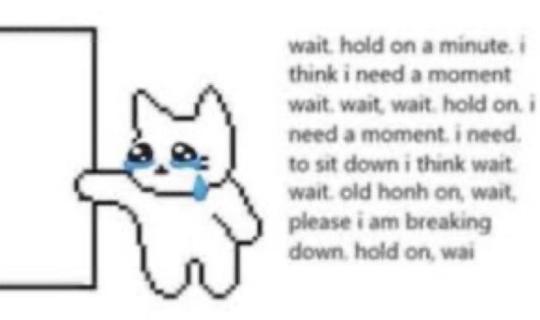
Aaaa I don't wanan be self indulgent on main but waaaaa aghaaa,
Working on Astronought last year was meant to be a break from writing MO. I think I manifested something when writing for Atom, they're such a goofy obsessive goober with absurd sci-fi logic almost to the point of comical sometimes and I just had fun with it!!
To think someone noticed all the silly little details that were just meant for me to see when it comes to the file names and references and even the title when I was working on it means so much!! This one is definitely a message I'll come back to over and over, especially for a short one-shot game.
Thank you so much <3<3<3!
#astronought vn#jar of fireflies#im so lucky to have people that go out of their way to send me such kind supportive messages like these#it always means so much when someone enjoys your work this much#i highly encourage taking the time to do it for other devs too!!! <3
241 notes
·
View notes
Text
okay i'm back from the movies let's talk about screen and multiply layers

you can read part 1 of this series of tutorial posts where i mostly talk about gradient maps here.
now we're going to talk about the other layer effects. i feel like these ones are already pretty commonly known, but i've also been using them for like 15 years so it's very easy to assume everyone knows everything but actually i'm just old. anyway.
the panel up top is where we're starting from. i've got a nice blue color gradient applied, and everything looks a bit more harmonious. but...... those inks are pretty harsh, especially in contrast to the background, where there's no black inks at all. i'd like everything to come together a little more.
you can do this with a gradient map, if the darkest value is set higher than black. but since we're not using the gradient map at 100% (it's just 30%) the black isn't really affected by it. so it just stays black.
what a screen layer will do--and this is in practice, i don't know what it's actually mathematically doing--is turn your darkest value into whatever color is on the screen layer. so this is what a screen layer set to 100% would do to this panel. (NOTE: all the layers applied in this post are clipped to a folder containing just the characters. they are not affecting the backgrounds, they'll just affect the characters. the gradient map does affect everything)
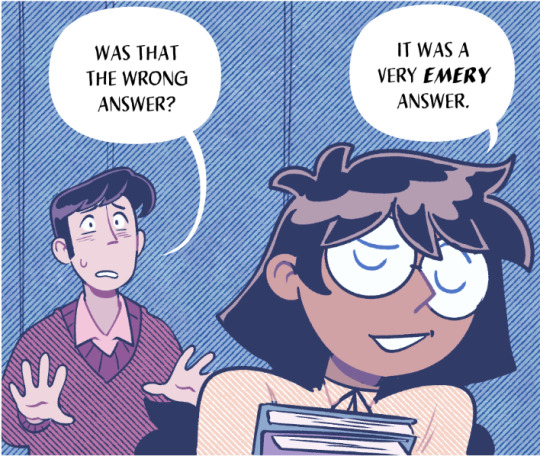
That's Pretty Blue! the color that neeta's hair currently appears is the color of the layer. everything else is lightened up and also made a little more blue. and this doesn't look terrible, but screen layers will pretty much always make your art a bit lighter, because it's trying to make its color the darkest color. tbh it's great for fog effects and making your blacks light enough that a texture can show up in them. but let's turn it down a bit, to 40%.

hey nice. everything is still a bit lighter, but neeta and emery's hair isn't as sharp against the background. still enough that they stand out as the most important things in the panel, but not so much that they feel pasted overtop. it's a bit like putting some atmospheric perspective between you, the reader, and the characters. there's air in the image. (and why it's good for fog!)
but i want it just a little darker to make up for the lightening up that happened. i don't think i actually need to explain multiply layers, because everyone has definitely used those for shading at one point or another. but here i'm using a very very light blue over the entire characters. i'm not using it for shadows, but to make everything a bit blue.
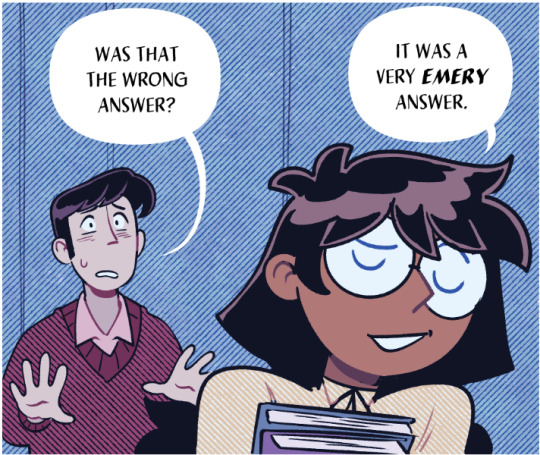
now it really feels like they're in a room. the only pure white is the speech bubble and gutters. their eyes/teeth/glasses will still read as white, but they are not white. everything is at least a Little blue, so everything is unified.
and that panel above is what the final looks like! let's look at it side by side with just the gradient map.


neat! it would be perfectly acceptable to stop with just the gradient map, if you value high contrast black inks and characters popping off the page. i... don't! i like the air that's generated by going a little bit lighter overall. it has a nice matte effect, which is why i'm very glad my book was printed on matte paper.
and that's why hunger's bite looks so good. you should buy it and read it
344 notes
·
View notes
Note
Don't wanna be a bother but I bumped into ur touchstarved oc stuff and do you have any pointers for drawing in the touchstarved style? I can't really nail it down 100% but you do so... pretty please?
Hii yeah ofc, it's no bother at all no worries! You sent me this at the right time actually jsdhksd I'm in the middle of redesigning Emma right now and I've been taking a close look at the art style again, so it's all fresh in my mind!
Assuming you already have your design ready and have found a pose or composition you like, replicating the art style will probably come down to getting the lineart and shading to look similar.
About the lineart:
Probably goes without saying, but you'll need a pen with the opacity turned off to get the clean, ink-like lines. If you use CSP I recommend the default textured pen, which I think has a similar look, but honestly any pen will do.
The thing you have to look out for the most when doing the lines is the darkest shadows. It's a bit tricky to explain, and I think a lot of it comes with practice, but you have to look for the places where the darkest shadows would be, or where the light could barely reach. Once you spot them, instead of shading them you create a sharp shape and paint them black, like so:
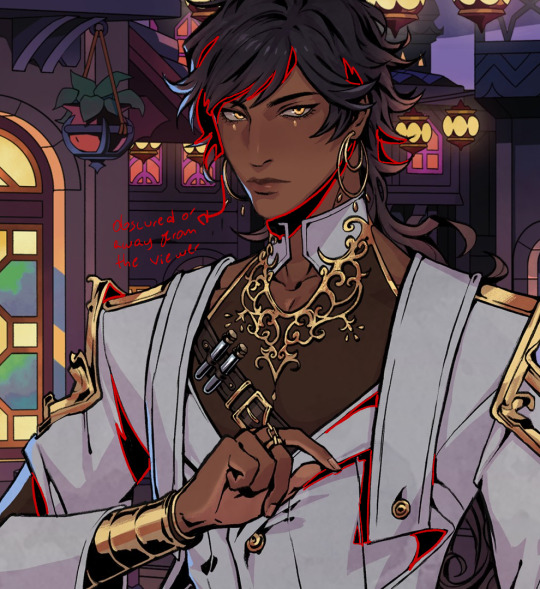
I also recommend varying the thickness of your lines, but not at random. Instead, try to keep lighting in mind while you draw them. You could draw one continuous thin line for something, and then only thicken it where it falls away from the light, or where it'd create an occlusion, or wherever you want a shape to stand out from another. A thick line will essentially either "push back" or separate things in space, while a thin line will pull it forward or make things look like they're closer together.
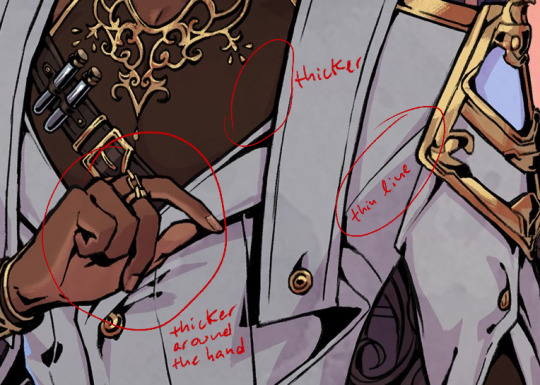

You can also exaggerate the shadows in order to create more contrast. Like in the case of Kuras' sleeves and coat, for example- you could argue that some bounce light could still get in there, but with the shadows exaggerated it creates a really nice, clean shape. You can also separate these shapes from other lines by leaving a small space between them and the lines.
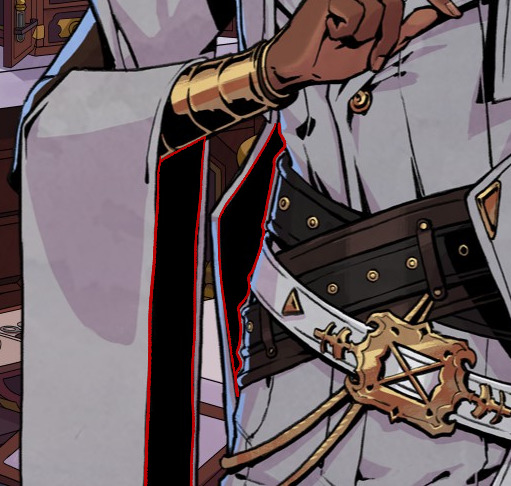

The metal might look a bit different, but it follows the same logic as everything else- your darkest shadows will be pure black. It might look like it has more shadows but that's just because it's more reflective, so the light is usually concentrated on highlight and bounce light areas, so the tones around those areas will be darker.
About the shading:
From what I've noticed, it's all about keeping it subtle and simple. If you color pick the characters, you can see the variation between light and shadow is subtle and not all that contrasting. Most of the contrast is done with colors, not values.


The light source is usually from the top right, characters are pretty well lit, and there's a little bit of a blue backlight from the left that helps them stand out against the backgrounds.
The shading is mostly sharp, cel shading, rarely blended. Wherever there's blending, it's usually subtle or a gradient
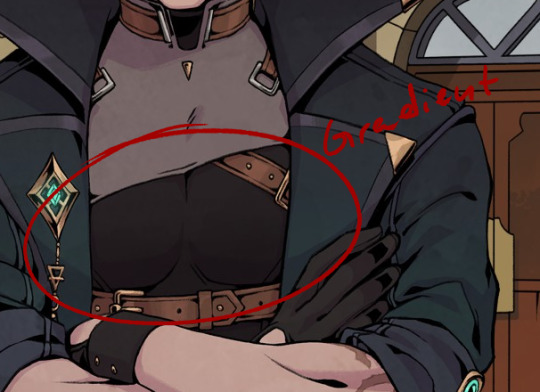
They also use gradations to indicate color shifts, like the colors in Leander's coat. You can do this with the gradient tool or an airbrush.
I recommend picking 1 color for light, 1 color for shadow, and maybe 1 inbetween midtone to use sparingly in places where you want a very subtle shadow. You can go more fancy if you're trying to create something that looks more like the game's CGs, but if you're going for the same look as the sprites, it's better to keep it simple.
You can shade manually each part of the character, or you can try using a multiply layer. For multiply, I like shifting the color towards a warm or pinkish tone and keeping it light and desaturated to get a similar look as the sprites.
Highlights are used very sparingly, only on a few places like the nose, mouth, eyes, and a few on the hair. Maybe occasionally somewhere else, but only if necessary, like in the case of very reflective materials like metal, gold, glass and leather.
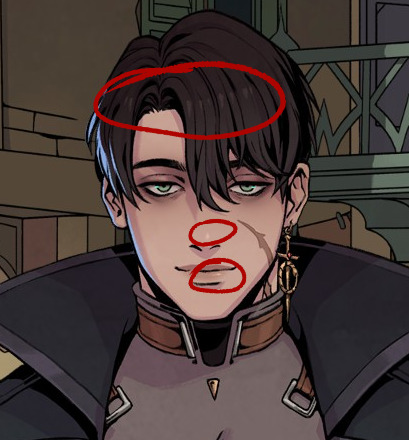
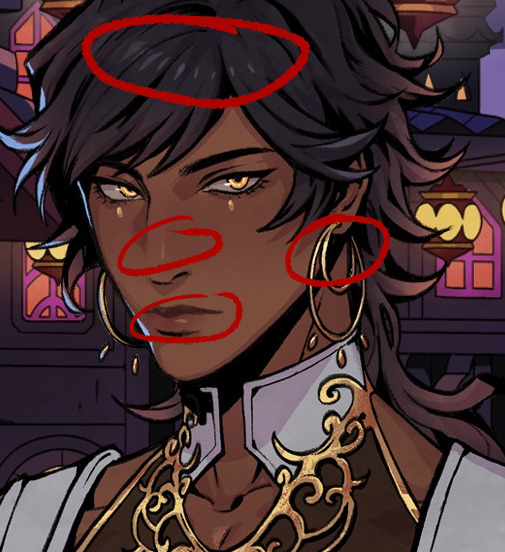
The characters also usually have subtle textures on their clothes, and you can quickly create something similar by using a textured brush and an overlay or multiply mode. Like so:
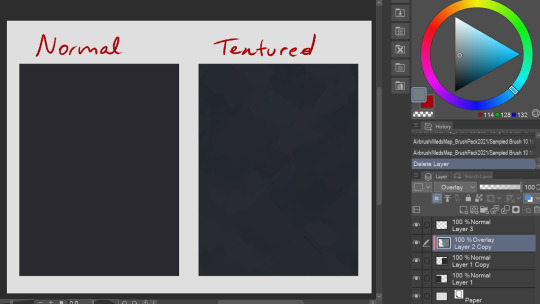
It's subtle, but makes a difference in my opinion! You can try this with a lot of different textured brushes to get the exact look you're going for.
That's all I could think of right now! If you have any questions or wanna know anything specific I didn't mention here, let me know!
152 notes
·
View notes
Text
Reality Shifting and Race Changing Explained: A Deep and Comprehensive Analysis of the Practice through the Perspective of a Person of Color.
Introduction :
Reality shifting, a practice where individuals consciously move their awareness to alternate realities or dimensions, has gained significant popularity and attention. Within this phenomenon, race changing—where shifters assume a different racial identity in their Desired Reality (DR)—has become a particularly contentious topic. Proponents of race changing see it as a way to explore different perspectives, foster empathy, and experience personal growth. However, critics raise concerns about cultural appropriation, identity integrity, and ethical implications. This essay will delve into the shifter's perspective and debunk arguments against race changing in reality shifting, examining the diverse viewpoints and underlying controversies.
Disclaimer : before interacting pls read the entire post carefully if you do not understand a part of it do not hesistate to tell me and i would gladly explain you in more details.
And as the title says im a person of color (POC) so i will give my opinion on the matter. I am lowkey (more high key lol) pissed that i see white people telling and talking about it as if they opinion is law its time you let people directly concerned by the matter speak on a subject that concerns them.
Taglist of people who might be interested in this post that i will update progressively i will also at the end provide a pdf version of the document if this post reaches 100 reactions if it reaches 150 to 200 i will also provide the one against age changing) :
@shiftinghoe @shiftersroom @leydenkilgore @jolynesmom @shiftinginferno @norumis @angelscatastrophe @thanossnap
My Age changing Post for those interested
Masterlist
Part I: The Shifter's Perspective
A-Immersive Nature of Reality Shifting
Reality shifting goes beyond elaborate daydreaming or role-playing. It's a full-fledged immersive experience where individuals become their "Desired Reality" (DR) selves entirely. This deep embodiment isn't just physical; it encompasses cultural, emotional, and even historical elements.
Shifters often perceive themselves with entirely different physical characteristics in their DR. This goes beyond appearance – they feel comfortable and familiar in their new bodies, experiencing unique sensations and abilities tied to their DR race. Imagine an East Asian shifter feeling their epicanthic folds affecting their vision or an Afro-Caribbean shifter experiencing the textures of their hair and the specific needs of their skin.
But it's not just physical. Shifters become integrated members of their DR culture. They might find themselves fluent in the language, complete with cultural nuances and dialects. They possess an intrinsic understanding of traditions and social norms, not just intellectually, but on a lived level. Family histories, community connections, and social networks become as real and meaningful as those in their original reality.
Perhaps the most profound aspect is the emotional and psychological alignment. Shifters report feeling emotions differently based on their DR cultural background. Their worldview, values, and beliefs shift to reflect their new identity, offering unique perspectives. Many even have a full set of memories associated with their DR life, from childhood experiences to major events.
Shifters don't just inhabit a new identity; they become part of a complex historical and societal narrative. They understand the weight of historical events that shaped their DR community and experience firsthand the societal advantages or disadvantages of their DR race. They feel a deep sense of cultural pride alongside the challenges and discrimination that may come with it.
For example, a Japanese shifter might not only speak the language fluently but also understand the intricacies of keigo and feel the emotional weight of concepts like "gaman" or "uchi-soto." They could have memories of local festivals, the excitement of catching goldfish, or the solemnity of a New Year's visit.
Similarly, a Latinx shifter might effortlessly switch between languages, understand the cultural significance of quinceañeras, and feel a deep connection to their abuela's traditions. They could have vivid memories of family gatherings filled with traditional foods, laughter-filled conversations, and the warmth of close family bonds.
This immersive experience allows shifters to see the world through a completely different lens, gaining insights otherwise impossible. In their DR, their new identity isn't a costume – it's as authentic and valid as their original self. This creates a profound sense of belonging and allows them to explore different aspects of identity in a meaningful way. This depth of experience is what proponents of race changing in reality shifting often highlight as a potential benefit.
B-Personal Growth and Empathy Development
Reality shifting, particularly when it involves changing race, offers a powerful pathway for personal growth and empathy development. Proponents believe this to be one of its most valuable benefits. Here's a breakdown of its potential:
Expanded Perspective: Shifters inhabit a different racial identity, gaining visceral, firsthand experiences. Imagine a Black shifter feeling the sting of racism, or an Asian shifter navigating the pressures of the "model minority" stereotype. This fosters a deeper understanding of racial dynamics beyond textbook knowledge.
Cultural Competence: Shifters become immersed in a new cultural context, enhancing their cultural competence. They gain insights into cultural nuances, values, communication styles, and nonverbal cues. For instance, a shifter embodying a Middle Eastern identity might understand the significance of hospitality, appreciating the cultural roots of seemingly excessive generosity.
Challenging Biases: The immersive nature of shifting exposes personal biases. Shifters confront and work through unconscious biases and stereotypes that may seem harmless from the outside, but feel hurtful or limiting from a different perspective. This uncomfortable process can be ultimately transformative.
Emotional Intelligence: Experiencing life through a different racial lens boosts emotional intelligence. Shifters develop empathy for the struggles and joys specific to different races, better understand emotional cues across cultures, and gain enhanced self-awareness through reflecting on their reactions in their new identity.
Social Justice Awareness: Shifters often report a heightened commitment to social justice and equity. Experiencing discrimination firsthand motivates them to become allies in their original reality. Understanding privilege (or lack thereof) associated with different races fosters nuanced discussions about systemic inequality.
Personal Identity Exploration: Race changing in shifting can prompt deep reflection on personal identity. Shifters might question aspects of their original identity, explore their cultural heritage and family history, and gain a greater appreciation for the fluidity and constructed nature of racial categories.
Linguistic and Cognitive Benefits: Shifters who become fluent in new languages experience cognitive benefits like enhanced cognitive flexibility from thinking in different linguistic frameworks and improved problem-solving skills as they navigate cultural and linguistic differences.
Artistic and Creative Inspiration: The rich experiences gained through race changing can serve as a wellspring of artistic and creative inspiration. Writers might create more authentic characters, while visual artists gain new perspectives on color, form, and cultural symbolism.
Professional Development: Insights gained through race changing can translate into professional growth. Shifters develop a stronger ability to work in diverse teams, enhance their cross-cultural communication and negotiation skills, and gain a deeper understanding that can be valuable in multicultural environments.
Healing and Trauma Processing: In some cases, embodying different racial identities has helped shifters process personal or intergenerational trauma. For instance, a shifter with a family history of racial oppression might find healing in embodying an identity free from that specific trauma. Conversely, embodying an identity that has experienced historical trauma might help shifters connect with and process their own unrelated traumatic experiences.
Part II: Debunking Arguments Against Race Changing
A-Cultural Appropriation
One of the primary arguments against race changing in reality shifting is that it constitutes cultural appropriation. This issue is complex and sensitive, requiring careful consideration.
Cultural appropriation involves adopting elements from one culture by members of another, often without a full understanding or respect for the original culture. This practice is typically characterized by a power imbalance, where the appropriating group holds more social, political, or economic power than the culture being appropriated. It also involves a lack of attribution, where the source of cultural elements is not acknowledged, leading to stereotyping and commodification of cultural symbols, often out of context and for profit.
Applying this argument to reality shifting, critics assert that when individuals assume a different racial identity in their desired reality (DR), they may trivialize the lived experiences of that racial group. They argue that such individuals might cherry-pick enjoyable aspects of the culture while avoiding its challenges and potentially reinforcing stereotypes or misconceptions about the culture.
However, several counterarguments challenge this perspective. Many shifters approach race changing with the intention of understanding and empathizing with different racial identities, rather than exploiting them. The immersive nature of shifting often involves a deep engagement with the culture, as opposed to the superficial adoption of isolated elements.
Moreover, cultural appropriation typically involves a dominant culture taking from a marginalized one, but in shifting, this power dynamic isn’t present. Shifters embody the new identity fully, integrating their experiences into the fabric of the DR, which can make their engagement more authentic.
Unlike typical cases of cultural appropriation, shifters often report experiencing both the positive and negative aspects of their new racial identity, including potential discrimination and societal challenges. This level of immersion extends far beyond wearing traditional clothing or using cultural symbols, as it involves a comprehensive engagement with the culture's values, traditions, and worldview.
Reality shifting is a personal and introspective practice, usually conducted privately or in small groups, rather than as a public display that might perpetuate stereotypes or commercialize the culture. This personal and nuanced approach differentiates it from more harmful forms of cultural appropriation seen in popular culture or commercial contexts.
Despite these counterarguments, there are still ethical concerns to consider. The ability to "opt out" of a racial identity at will is a privilege not available to those who live that identity full-time. There is also a risk of oversimplification or misrepresentation, even with the best intentions. The personal nature of shifting does not negate the potential for internalized stereotypes or biases to influence the experience.
Instead of viewing race changing in shifting as clear-cut cultural appropriation, it might be more accurate to see it as a complex form of cultural engagement. This practice has the potential for both positive outcomes, such as increased empathy and understanding, and negative outcomes, like reinforcing stereotypes or trivializing experiences. It requires careful reflection and ethical consideration from practitioners and might be evaluated on a case-by-case basis, considering the shifter's intent, approach, and outcomes.
The argument that race changing in reality shifting constitutes cultural appropriation could be seen as a false analogy fallacy, inaccurately equating the personal, immersive, and often respectful experience of shifting with the exploitative and superficial nature of cultural appropriation as traditionally understood. Some proponents suggest that, when conducted respectfully and thoughtfully, race changing in shifting could be seen as a form of cultural exchange rather than appropriation. This perspective posits that the immersive nature of shifting fosters genuine understanding and appreciation, with shifters often feeling a responsibility to respect and honor the cultures they embody. The insights gained can contribute to more meaningful cross-cultural dialogue and understanding in the shifter's original reality.
In conclusion, while the argument against race changing in reality shifting raises important ethical considerations, the issue is more nuanced than it might initially appear. The deeply personal and immersive nature of shifting, coupled with the often sincere intent of practitioners to gain understanding and empathy, sets it apart from more straightforward cases of cultural appropriation. Nevertheless, it remains crucial for shifters to approach the practice with respect, self-reflection, and a willingness to grapple with its complex ethical implications.
B-Fetishization
Another significant criticism of race changing in reality shifting is that it may lead to or represent a form of racial fetishization. This concern is both sensitive and complex, and warrants a thorough examination.
Racial fetishization involves reducing individuals to stereotypical racial characteristics, objectifying people based on their race or ethnicity, and exoticizing racial features or cultural elements. Often, though not always, it includes a sexual component. Critics argue that race changing in shifting might encourage shifters to focus on stereotypical or exoticized aspects of a race, leading to a superficial engagement with racial identity that is more fantasy than reality. This practice could potentially reinforce harmful stereotypes or racial preferences.
However, several counterarguments challenge this perspective. Many shifters who engage in race changing are not primarily motivated by sexual desire or attraction to stereotypical racial attributes. Their goal is often to understand and embody the full spectrum of experiences associated with a different racial identity, rather than to indulge in fantasy or stereotypes. The immersive nature of reality shifting encourages shifters to deeply engage with and appreciate the culture they are exploring. This process frequently fosters empathy and understanding, rather than objectification, as shifters report experiencing both positive and negative aspects of their new racial identity, extending beyond surface-level engagement.
Additionally, many shifters approach race changing as a means of personal growth, aiming to challenge their own biases and expand their worldview. This experience often leads to increased cultural sensitivity and awareness, rather than reinforcing stereotypes. In their desired reality (DR), shifters often experience a fully realized and complex identity that includes family histories, cultural practices, societal challenges, and individual personality traits, going far beyond mere racial characteristics.
Despite these counterarguments, it is important to acknowledge potential risks. Shifters might unknowingly bring racial stereotypes or biases into their DR experiences. There is also a risk of focusing on more "appealing" aspects of a racial identity while downplaying its challenges or complexities. The ability to "try on" different racial identities at will is a privilege that could lead to a form of racial tourism if not approached thoughtfully.
From a psychological standpoint, the experience of race changing in shifting could be seen as a form of identity exploration rather than fetishization. It serves as an exercise in perspective-taking and empathy development and provides an opportunity to confront and work through internalized racial biases.
Culturally, it is worth considering whether race changing practices in shifting might lead to more nuanced representations of diverse racial identities in media and art, foster more open dialogue about race and identity in society, or risk oversimplifying complex racial issues.
Ethically, shifters should be encouraged to reflect critically on their motivations and experiences, seek diverse perspectives and real-world knowledge about the races they embody in their DR, and be mindful of the line between appreciation and fetishization. The argument that race changing in reality shifting constitutes fetishization could be seen as a straw man fallacy, as it misrepresents the shifters' intentions and the nature of their experiences, reducing a complex and often empathetic practice to a simplistic and objectifying one.
Some proponents argue that race changing in shifting could help deconstruct harmful racial categories by highlighting the constructed nature of race, encouraging people to see beyond racial stereotypes, and fostering a more fluid understanding of identity. Comparing this practice to other activities, such as actors portraying characters of different races, virtual reality experiences designed to foster racial empathy, or imagining oneself in someone else’s shoes through literature or film, reveals that race changing in shifting may differ fundamentally from these practices in its approach and intent.
In conclusion, while the criticism of fetishization raises important concerns about the potential risks of race changing in reality shifting, a closer examination reveals a more nuanced picture. The deeply personal and often transformative nature of these experiences, combined with the typical intent of fostering understanding and empathy, sets it apart from more straightforward cases of racial fetishization. Nevertheless, it is essential for shifters to approach the practice with self-awareness, respect, and a commitment to genuine cultural engagement rather than superficial or stereotypical representations.
C-Race Changing is Racist
The argument that race changing in reality shifting is fundamentally racist is a serious allegation that requires careful examination. This perspective is based on several concerns: it may trivialize the real struggles and discrimination faced by racial minorities, allow individuals to "play" at being another race without encountering the associated societal challenges, perpetuate the idea that race is something that can be donned or discarded at will, and reinforce the notion that race is merely about physical characteristics or stereotypical behaviors. This criticism often stems from worries about cultural insensitivity, fears of minimizing systemic racism, and the historical context of racist practices such as blackface and yellowface.
However, this argument can be contested on multiple grounds. Firstly, many shifters engage in race changing not to mock or belittle other races but to gain a deeper understanding and empathy for those experiences. The immersive nature of shifting often results in increased awareness of racial issues and a stronger commitment to anti-racism in the shifter's original reality. Furthermore, shifters in their desired reality (DR) often experience life as an integrated part of the culture they embody, including facing discrimination and navigating societal challenges associated with that racial identity. This depth of experience goes beyond superficial engagement.
Additionally, race changing can lead to significant personal transformation. Many shifters report profound growth, challenging their own biases and increasing their cultural competence. These experiences foster a deep sense of connection and solidarity with different racial groups. Race changing could also be viewed as an immersive form of education about racial experiences, potentially offering more impactful learning than traditional methods.
Despite these counterarguments, it is crucial to acknowledge potential issues. Shifters have the privilege of opting out of their new racial identity and returning to their original reality, a luxury not available to those who face racism daily. There is also a risk of oversimplifying complex racial experiences into simplified narratives. Without proper reflection, shifters might misuse or misrepresent aspects of the racial identities they embody.
To address these concerns, shifters engaging in race changing should approach the practice with humility and a willingness to learn. Complementing their shifting experiences with real-world education about racial issues and using insights gained to actively combat racism in their original reality can help mitigate potential problems. Critical reflection on their experiences and motivations is also essential.
From a psychological perspective, race changing in shifting can be seen as a form of perspective-taking, which has been shown to reduce prejudice, an exercise in empathy development, and a way to confront and work through unconscious racial biases. Sociologically, it is worth considering whether widespread engagement in race changing might lead to increased racial empathy, contribute to a more nuanced understanding of race as a social construct, or challenge existing racial categories.
A comparative analysis with other practices such as diversity training programs, role-playing exercises in anti-racism workshops, and the concept of "passing" in racial identity reveals that race changing in shifting might differ fundamentally in its approach and intent. The argument that race changing is inherently racist may be seen as a hasty generalization fallacy, drawing broad conclusions based on limited understandings of shifters' experiences and motivations.
Some proponents argue that, when approached thoughtfully, race changing in shifting could be an antiracist practice by fostering a deeper understanding of diverse racial experiences, motivating action against racism in the shifter’s original reality, and challenging fixed racial categories. Considering how race changing intersects with other aspects of identity, such as gender, class, or sexuality, further complicates the discussion and could lead to a more nuanced understanding of intersectional identities.
In conclusion, while the argument that race changing in reality shifting is inherently racist raises important ethical concerns, a closer examination suggests a more complex picture. The potential for increased empathy, understanding, and antiracist action indicates that, when approached thoughtfully and ethically, race changing in shifting might contribute to combating racism rather than perpetuating it.
Part III: Community Dynamics :
A. Shiftok Culture and Hypocrisy
The community of shifters on platforms like Shiftok has become a significant space for discussing and sharing experiences related to reality shifting. However, this community is often marked by striking inconsistencies in its attitudes and practices, particularly when it comes to race changing. These inconsistencies reveal underlying biases and a selective application of ethical standards within the community.
One of the most glaring examples of this hypocrisy is the community's disparate treatment of shifts involving fictional races versus real-world racial identities. Users enthusiastically support and celebrate shifts into races from popular fiction, such as elves from "Lord of the Rings" or Veela from "Harry Potter." These shifts often involve adopting stereotypical characteristics of these races, such as ethereal beauty or magical abilities, without any criticism. Similarly, shifts into anime characters, even when these characters are explicitly Japanese or of other Asian ethnicities, are widely accepted and applauded.
In stark contrast, when a user mentions shifting to experience life as a different real-world race - for example, a white person shifting to be Black, or an Asian person shifting to be Latino - they often face harsh criticism and accusations of racism or cultural appropriation. This double standard extends to cultural practices as well. Users might criticize someone for shifting to experience a traditional Japanese tea ceremony as a Japanese person, calling it appropriation. However, they remain silent when shifters adopt fantastical versions of cultural practices, such as magical rituals in The Vampire Diaries Universe, which are often based on real-world cultural elements such as Hoodoo and Voodoo.
The inconsistency becomes even more apparent when considering shifts into races that face oppression or discrimination in their fictional universes. Shifting to be a Na'vi from "Avatar," who face colonization and violence from humans, or becoming a vampire who must hide from hunters and deal with societal prejudice, are widely accepted and even romanticized. These shifts often involve experiencing fictional forms of racism or oppression, yet they don't receive the same scrutiny as shifts involving real-world racial experiences.
This romanticization of struggle is particularly problematic. Users might enthusiastically describe the thrill of being a hunted vampire or the nobility of fighting against oppression as a Na'vi, while simultaneously criticizing those who wish to explore real-world experiences of discrimination through shifting. This glamorization of fictional oppression trivializes real-world struggles and reveals a lack of critical thinking about the implications of different types of identity shifts.
The community's acceptance of shifts into historical periods further highlights this hypocrisy. Shifting to experience life in different historical eras, which inevitably involves a change in cultural context, is generally supported. For instance, shifting to be a noble in Victorian England is rarely questioned, while shifting to be a person of color in modern-day America might be condemned. This inconsistency reveals a troubling bias in how the community views and values different cultural and racial experiences.
Perhaps the most striking example of this double standard is the widespread acceptance of shifting to become a Na'vi from the movie "Avatar." This shift involves taking on a completely different racial identity, often with spiritual and cultural elements inspired by real-world Indigenous cultures. Yet, this is rarely criticized, while shifting to be an actual Indigenous person would likely face significant backlash.
These inconsistencies in the Shiftok community undermine the credibility of criticisms against race changing and point to a need for more consistent and reflective ethical standards within the shifting community. They reveal that many users are more comfortable with the idea of exploring different identities and experiences of oppression when they're framed as "fictional," even though the immersive nature of shifting means these experiences are just as real to the shifter as any "real-world" shift would be.
This hypocrisy not only stifles meaningful dialogue about race and identity within the context of shifting but also reflects broader societal discomfort with addressing real-world racial issues. It highlights the need for the shifting community to engage in more nuanced, thoughtful discussions about the ethics of identity exploration, the nature of reality in shifting, and the responsibilities that come with experiencing different racial and cultural perspectives.
B. Judgmental Attitudes and Ignorance
The shifting community, particularly on platforms like Shiftok, often displays a complex web of judgmental attitudes and ignorance about the nuances of shifting practices. This creates a challenging environment for shifters exploring different identities, especially when it comes to race changing. (in this part and all the other parts of this essay, “real world”=CR aka this reality ik they are no such thing as the “real world” but for the sake of the argument i employed that term).
Many users within the community are quick to condemn those who shift into different racial identities, particularly when these involve real-world races. This rush to judgment often stems from a superficial understanding of shifting practices and a lack of empathy for the motivations behind such explorations. Harsh comments, gatekeeping behaviors, and in extreme cases, online harassment, have become unfortunately common responses to shifters who engage in race changing.
However, this judgmental attitude is starkly contrasted by the community's acceptance and even celebration of shifts into fictional races or non-human identities. This inconsistency reveals a deep-seated ignorance about the nature of shifting and its implications. Users often justify their acceptance of shifts into fictional races like Elves or vampires from various mythologies by arguing that since these races are fictional, they're somehow "safer" or less problematic to explore. This reasoning, however, fundamentally misunderstands the core principle of shifting: that all realities, whether based on fiction or the "real world," are equally real and valid from the perspective of the shifter.
This ignorance leads to a troubling double standard. Shifters who explore the experiences of fictional races facing discrimination - like the Na'vi battling colonization or werewolves hiding from hunters - are often met with enthusiasm. The community readily engages with these narratives of struggle and oppression when framed in a fictional context. Yet, when shifters attempt to explore real-world experiences of racial discrimination, they face harsh criticism and accusations of appropriation or fetishization.
This attitude demonstrates a lack of critical thinking about the ethical implications of different types of shifts. The community fails to recognize that from the perspective of shifting theory, the distinction between "fictional" and "real-world" races becomes arbitrary. The experiences of discrimination, cultural immersion, and identity exploration are just as real and impactful for a shifter whether they're embodying a Na'vi or shifting into a different human race.
Moreover, this ignorance extends to a misunderstanding of the depth and complexity of shifting experiences. Many critics within the community underestimate how fully shifters can embody and experience a different identity, regardless of whether it's fictional or based on a real-world race. They often fail to grasp the profound impact these experiences can have on a shifter's perspective, empathy, and personal growth.
The judgmental attitudes and ignorance prevalent in the community have serious consequences. They stifle open and honest discussions about race and identity within the shifting context. Shifters who feel judged may withdraw from the community or hide their experiences, limiting opportunities for collective learning and growth. The hostile environment can discourage exploration of different identities, potentially limiting the personal growth and empathy development that shifting can facilitate.
Furthermore, this environment of judgment and ignorance often leads to the mischaracterization of shifting experiences. Complex and nuanced explorations of identity are frequently oversimplified or dismissed. The potential benefits of respectful identity exploration through shifting are overlooked, while stereotypes about shifting and shifters are reinforced.
To address these issues, there's a clear need for more education within the community about the nuances and complexities of shifting experiences. Promoting a deeper understanding of the psychological and experiential aspects of shifting could foster more empathy and less judgment. Creating spaces for open, non-judgmental discussions about controversial shifting practices could help combat ignorance and promote a more nuanced understanding of the ethical implications of different types of shifts.
By confronting these judgmental attitudes and areas of ignorance, the shifting community has the opportunity to create a more inclusive, understanding, and supportive environment. This could not only improve the experiences of individual shifters but also contribute to more nuanced and productive discussions about identity, race, and the ethics of shifting practices. Ultimately, addressing these issues is crucial for the growth and maturation of the shifting community as a whole.
C-Understanding Morality and Multiracial Identity in Shifting
The concept of infinite realities in shifting brings about profound implications for our understanding of morality and identity, particularly when it comes to race. Each Desired Reality (DR) has its own unique set of morals and cultural norms, presenting a challenge when applying Original Reality (OR) ethics to these varied experiences. This moral relativism in shifting creates a complex landscape where what is considered ethically acceptable in one reality may not hold the same value in another.
The shifting community's approach to fictional races inadvertently highlights this moral complexity. Many shifters enthusiastically embrace identities like Na'vi from "Avatar" or vampires from various mythologies, often without the same level of ethical scrutiny applied to shifts involving CR races. This discrepancy reveals a fundamental misunderstanding of the nature of shifting itself. If we accept the core principle that all realities are equally real and valid, then the distinction between "fictional" and "real-world" races becomes very blurry to a point where said distinction vanishes since what is fictional in this reality is 100% real in that DR.
This paradox becomes even more apparent when we consider that many of these fictional races face discrimination, oppression, or complex social challenges within their realities. Shifters who take on these identities are, in essence, experiencing forms of racism or societal prejudice, yet these experiences are often romanticized or seen as less problematic than explorations of real-world racial discrimination. The Na'vi fighting against human colonization or Mutants from the X-men hiding from societal persecution are, within the context of shifting, as real and significant as any historical or contemporary struggle against oppression.
The romanticization of these fictional races raises its own set of moral questions. For instance, the glorification/romanticisation of vampire culture in shifting could be seen as problematic on multiple levels. It potentially trivializes issues of consent and power imbalances, and could even be construed as a form of necrophilia, given the undead nature of vampires (vampires are dead not alive ergo necrophilia in a way. This argument that I use is to further emphasize the hypocrisy of the shifting community since yall wanna talk about fetishization and romanticisation). This level of ethical scrutiny is rarely applied to fictional race shifts, despite the community's readiness to criticize CR race changing on similar grounds.
For multiracial shifters, this moral landscape becomes even more complex. A multiracial individual might choose to shift to embody only one aspect of their racial heritage in their DR, reflecting their sense of connection and belonging to that part of their identity. This choice doesn't negate their other racial identities but rather reflects the fluid and personal nature of racial identity itself. However, the community's inconsistent approach to race in shifting can create additional challenges for these individuals. They may find themselves navigating not only their own complex identities but also the arbitrary distinctions and judgments imposed by the community.
The multiracial shifting experience underscores the limitations of rigid racial categorizations and highlights the need for a more nuanced understanding of race and identity within the shifting community. It challenges shifters to consider how their experiences across different realities might inform and expand their understanding of racial identity in their OR.
Moreover, the moral relativism inherent in shifting raises questions about the nature of ethical growth through these experiences. If a shifter encounters and adapts to vastly different moral frameworks across their DRs, how does this impact their core ethical beliefs? This moral fluidity could lead to a more nuanced and empathetic worldview, but it also risks ethical inconsistency or moral relativism taken to an extreme.
In conclusion, the intersection of morality and racial identity in shifting presents a rich area for exploration and discussion. It challenges our understanding of ethics, identity, and the nature of reality itself. By engaging with these complex ideas, the shifting community has the opportunity to foster more nuanced, empathetic, and inclusive approaches to race and identity. However, this requires a willingness to apply consistent ethical standards across all forms of shifting, whether they involve "real" or "fictional" races, and a commitment to deeper reflection on the moral implications of these profound experiences.
Conclusion :
Ultimately, we can argue that race changing in reality shifting isn't inherently problematic and can, in fact, be a powerful tool for personal and societal growth. The ability to experience life from diverse racial perspectives has the potential to challenge deeply ingrained biases, foster genuine empathy, and contribute to more nuanced discussions about race and identity in our society.
However, we must tread carefully to ensure that these practices do not veer into appropriation or fetishization. This requires:
Approaching race changing with respect, humility, and a genuine desire to learn.
Engaging in thorough self-reflection before, during, and after shifting experiences.
Complementing shifting experiences with real-world education about racial issues and histories.
Being mindful of the privilege inherent in being able to "opt out" of a racial identity.
Using insights gained from shifting to actively combat racism and promote understanding in one's original reality.
Fostering open, honest dialogues within the shifting community about ethics and best practices.
Developing clear community guidelines that address the complexities of race changing.
By maintaining this careful balance, race changing in reality shifting can serve as a unique and valuable tool for promoting intercultural understanding, challenging racial prejudices, and fostering a more empathetic and inclusive society. As with any powerful tool, its value lies not in the practice itself, but in how we choose to use it. With thoughtful consideration and ethical guidance, race changing in shifting has the potential to contribute positively to our ongoing dialogues about race, identity, and human experience.
#reality shifting#shiftblr#shifting#desired reality#shifting community#shifting realities#shifters#reality shift#reality shifter
463 notes
·
View notes
Text

It's done! Or at least I'm done and feel finished with it anyway. I really liked the scene this is referenced from from a color/perspective angle so why not a screenshot repaint for practice?
[Uncropped version + reference image + extended commentary under readmore]


Materials: oil paint on 6x8 canvas panel, it's slightly curved/warped for some reason? which may be why light reflections on it are a little odd sometimes. But it's all fine and not a huge deal. This took longer than I thought only because I went to go visit a friend (in February) and only got back around to finalizing earlier this month (March), hahaha. I'm still somewhat skeptical of the two different colors for the background mountains/trees but it is what it is, fun experiment either way. My favorite parts to do were definitely the sky and the flowers though. Realizing that this man is Just A Shape also helped me feel better about him there LMAO
Not really a fan of how the light is in my apartment generally, I still think there's either unnecessary/unintended light reflections going on but its gotta just be the canvas panel texture tbh, it does that both in photos AND in person at some angles. And I didn't want to use phone editor filters either, so, c'est business....it would look smoother with a varnish coating to fill those texture gaps in so might report back on that later (if I remember to!)
Ultimately this was pretty fun practice, like with many things I need to just get going and Do More Shit bcs I like the process and its cool to share the results too.
#kh#kingdom hearts#khux#kh mom#personal art tag#honestly kh is great for ideas for paintings. take an image from it and you could do something swag with art materials with it i bet#its Very Cool that way i think#love the url for this being the placeholder text while i worked on the rest of it LOL
210 notes
·
View notes